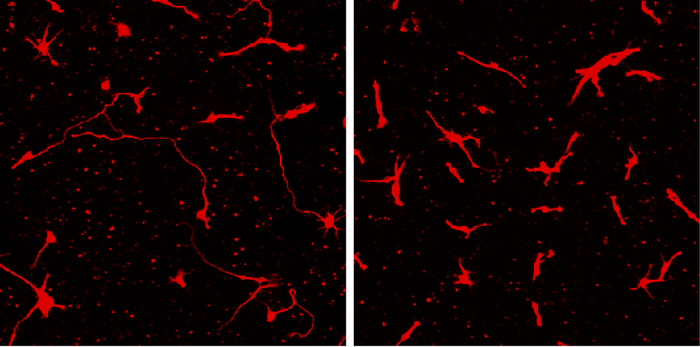It’s extremely difficult to study the biological basis of psychiatric disorders, in part because researchers can’t easily collect brain cells from living people to study in the laboratory. Now, University of Utah Health scientists have developed a way around that.

Credit: Guang Yang
It’s extremely difficult to study the biological basis of psychiatric disorders, in part because researchers can’t easily collect brain cells from living people to study in the laboratory. Now, University of Utah Health scientists have developed a way around that.
The researchers grew three-dimensional structures, called “organoids”, derived from blood cells donated by a patient with pediatric bipolar disorder and by several family members. The approach identified significant molecular changes linked to the psychiatric condition.
The results, reported in Molecular Psychiatry, suggest that structural changes in the brain seen in people with pediatric bipolar disorder may arise from dysfunction in a gene that assists with cellular signaling. The findings also demonstrate that lab-grown organoids can provide insights into causes of psychiatric disorders.
“If we don’t have animal models, there is no way to look for therapies in preclinical studies. It’s a huge challenge,” says Alex Shcheglovitov, Ph.D., assistant professor of neurobiology at University of Utah and senior author of the study. Graduate student Guang Yang was first author of the paper. “There’s definitely a need to develop new innovative models to study the cellular and molecular mechanisms disrupted in pediatric bipolar disorder.”
Changes in the bipolar brain
Bipolar disorder is a psychiatric condition that causes extreme mood swings, fluctuating between depression and mania. When the disease arises in childhood, it can be a sign that a strong genetic component is involved. Shcheglovitov and colleagues reasoned that such a complex disorder required an innovative, multidisciplinary approach to study it.
Melissa Lopez-Larson, M.D., psychiatrist and a co-author of the paper, has done brain imaging of children with pediatric bipolar disorder and their unaffected family members to look at how the disease changes the connections between brain regions. In people with bipolar disorder, an imaging technique called functional MRI, or fMRI, reveals changes in the brain’s resting activity, though it’s not known what causes these changes.
To learn more, Lopez-Larson collaborated with neurobiologists Shcheglovitov and Yang, and radiologists, geneticists, and psychiatrists at U of U Health and Huntsman Mental Health Institute, to combine imaging data with an in-depth analysis of patient cells at the molecular level.
Yang started with blood cells donated from a 9-year-old boy with bipolar disorder, his parents, and an unaffected sibling. By cultivating the cells under the right conditions, Yang induced them to become stem cells, which he then grew into neurons. The cells were then converted into structured clusters, called organoids, using an approach recently developed by the Shcheglovitov group. Organoids mimic early aspects of human brain development and allow researchers to study communication between neurons, similar to interactions that occur in the living brain.
“What these organoids allow us to do is to model certain developmental stages associated with certain brain regions,” says Shcheglovitov. “In our case, the are organoids are more like the frontal part of the fetal human brain.”
In search of a cause
To find root causes of the disorder, Yang ran tests to determine how cells from the child with bipolar disorder differed from his family members’. Yang discovered that the patient had a change in a gene called PLXNB1, which had previously been associated with psychiatric disease. He also found that cells looked different: neuronal processes called “neurites” were shorter. These long tendrils normally forge important connections with neighboring cells.
Adding normal PLXNB1 into the patient’s cells allowed the neurites to grow to normal size, confirming the mutation in PLXNB1 caused the changes in neurite growth. “This is super exciting,” says Shcheglovitov. “This suggests that, potentially, using gene-based therapy, or another treatment that targets the PLXNB1 pathway, could be therapeutically relevant for patients with pediatric bipolar disorder.”
Before the results can lead to new therapies, researchers will need to conduct larger studies to determine whether other people with this disorder share these same differences. The power of this study, Lopez-Larson says, was combining multiple technologies to create a robust picture of what’s happening in the brain.
“The fMRI showed that the brain connections are atypical, at least in this particular child. And we also found that was true with the genetic piece as well,” Lopez-Larson says. “We were able to use different kinds of advanced technologies that revealed the same thing in different ways.”
# # #
In addition to Shcheglovitov, Yang, and Lopez-Larson, additional coauthors were from the following University of Utah departments and institutes: H.M. Arif Ullah and Mark Liebowitz (Neurobiology), Ethan Parker (Bioengineering), Bushra Gorsi and Mark Yandell (Human Genetics), Colin Maguire (Utah Clinical & Translational Research Institute), Jace King and Jeffrey Anderson (Radiology) and Hilary Coon (Psychiatry, Huntsman Mental Health Institute).
The research was made possible by support from the Utah Neuroscience Initiative and Utah Genome Project and published as, “Neurite outgrowth deficits caused by rare PLXNB1 mutation in pediatric bipolar disorder.”
About University of Utah Health
University of Utah Health provides leading-edge and compassionate care for a referral area that encompasses Idaho, Wyoming, Montana, and much of Nevada. A hub for health sciences research and education in the region, U of U Health has a $458 million research enterprise and trains scientists, the majority of Utah’s physicians, and health care providers at its Colleges of Health, Nursing, and Pharmacy and Schools of Dentistry and Medicine. With more than 20,000 employees, the system includes 12 community clinics and five hospitals. U of U Health is recognized nationally as a transformative health care system and provider of world-class care.
Journal
Molecular Psychiatry
DOI
10.1038/s41380-023-02035-w
Method of Research
Experimental study
Subject of Research
Cells
Article Title
Neurite outgrowth deficits caused by rare PLXNB1 mutation in pediatric bipolar disorder
Article Publication Date
10-Apr-2023



